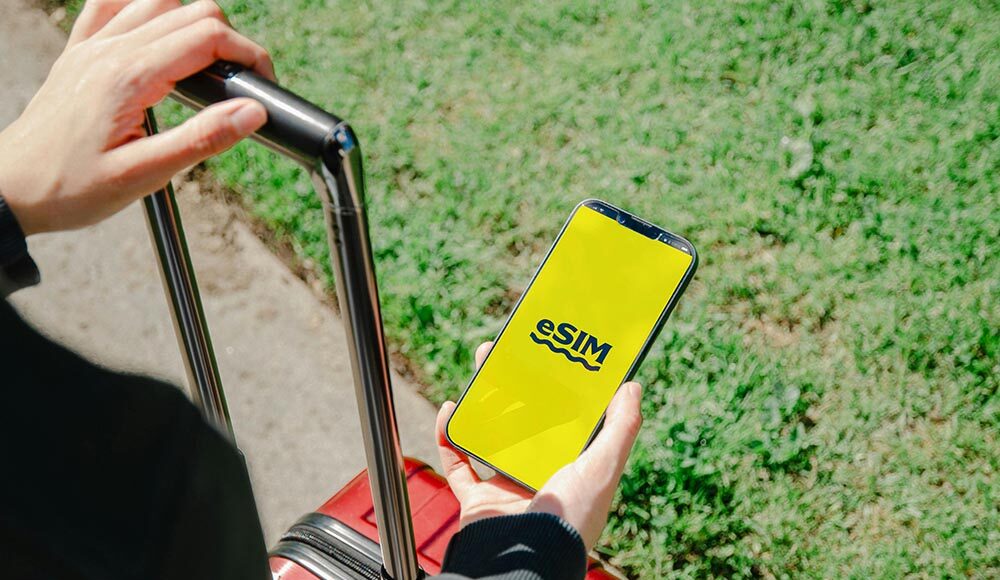Picture this: while you’re hiking in the magnificent mountain paths of Banff, you’ve somehow taken a wrong turn.
You look down at your phone and learn that you see no signal bars, and you’re not helping your plight with your costly international roaming plan for your mobile phone. Maybe you’re in the middle of Toronto and are trying to read the subway system, but your data connection keeps flickering out even though the city is the largest metropolitan area in Canada. There are thousands of travellers who experience this situation every day throughout the vast and different territories of Canada.
Canada represents unique connectivity needs that can either create a memorable travel experience or shatter it. Be it the hustle and bustle of urban hubs at Montreal and Vancouver or solitary wilderness at the Yukon Territory, staying connected requires more than hoping for your home carrier’s roaming agreement to be adequate. Solution? eSIM technology is redefining staying connected on wheels, with seamless coverage in Canada’s urban hotspots and countryside adventures.
The Challenges of Connectivity While Traveling in Canada
Canada’s vastness and geographical diversity present a convergence of connectivity issues that are hard to handle for conventional mobile solutions. Understanding these is the start of defining practical solutions to the Canadian experience.
Urban Hotspots: High Demand, High Costs
Canada’s big cities are oases of connectivity, but they also have a couple of issues of their own. Toronto’s downtown business district, home to millions, is perpetually congested during rush hour. Business travelers trying to bridge video calls from the lobby of hotels are frequently met with slow speeds that make professional communication nearly impossible.
Vancouver’s technologically inclined population places huge pressure on cellular networks, particularly in tourist areas such as Granville Street and along the water front. Tourists hoping for quick data rates frequently find themselves pushing locals and fellow tourists out of the way to secure bandwidth. Matters worsen during crowded events like film festivals or sporting events when network traffic increases exponentially.
Montreal is also challenging in its own way, especially for foreign visitors. Its extensive system of subway tunnels, though convenient, is plagued by dead spots where cellular reception is weak. travelers who depend on navigation apps lose signal just when they need it most.
The monetary blow is inflicted most forcefully in the guise of roaming charges. Foreign tourists often get $500-1000 bill shocks after a week of staying in Canadian urban areas despite attempts to keep their data usage in check. The charges mount from seemingly harmless activities such as browsing social media, accessing maps, or maintaining contact with relatives and friends back home.
Rural Adventures: Limited Coverage, Big Problems
Canada’s rural connectivity problems are much bigger than slow internet. In rural areas like Jasper National Park or the Maritime provinces, cell phone reception can disappear altogether for hours at a time. This is not just a nuisance—it can be fatal.
There was a terrifying incident from a German family who became lost on a road trip in northern Ontario last summer. Their GPS on their rented vehicle malfunctioned when they lost cell phone coverage, and they were stranded for six hours trying to figure out how to get themselves back on the highway. Without the possibility of dialing a call for help or viewing online maps, what was meant to be a scenic drive turned into a survival ordeal.
The Northwest Territories and Yukon Territory offer even more severe conditions. travelers will sometimes go hundreds of kilometers without a glimpse of a cell tower. Emergency responders suggest satellite communicators for anyone traveling into these areas, but most visitors aren’t aware of this until they’re already lost.
Prince Edward Island, the smallest province of Canada, curiously is not very well documented along its highway coastline. Visitors who want to take Instagram photos of the world-renowned red sand beaches can’t do so until they return to Charlottetown.
These connectivity problems in the rural areas are impacting more than just communication. Modern travelers expect to use their phones for anything from booking last-minute accommodations to getting directions to restaurants. When this connectivity is lost, it causes travel to revert back to 1995, with paper maps and guidebooks that were likely left at home!
Why Old SIM Cards Won’t Do for Canada Travel
The ancient method of getting connected overseas—buying local SIMs or roaming plans—is more of a headache than a relief for travelers now. Legacy methods such as these simply aren’t designed to meet the needs of travel today.
The Hassle of Physical SIM Purchases
It should be easy to purchase a Canadian SIM card, but it is much more complicated. Toronto Pearson Airport electronics shops have exorbitant prices for simple prepaid plans that never provide sufficient data for even modest tourist use. The process is standing in interminable lines, contending with language difficulties, and praying your phone is not locked to your home carrier.
Phone incompatibility problems haunt foreign visitors constantly. European phones operating on other frequency bands may not be accepted on Canadian providers, even after they have been fitted with a local SIM card. Technical incompatibility renders visitors with costly hardware that is useless.
The documentation requirements are yet another source of frustration. Canadian carriers request regional addresses and identification documents that foreign tourists do not possess. Fake information or hotel addresses are given by travelers, and this may lead to suspension of service without notice.
Limited selection of plans means that it is impossible to acquire coverage that reflects actual travel behavior. Prepaid plans tend to favor unlimited local calling at the cost of data caps. For international visitors who need data and not domestic calling, these plans are bad value and bad service.
Roaming Troubles with Home Providers
International roaming is equivalent to legalized theft to most visitors. An average roaming plan from an American carrier could be $10-15 a day for average data consumption in Canada. This would cost $140-210 for a two-week trip, adding to trip costs before considering overage charges.
The bill shock stories are a legend. One Aussie executive traveler incurred a $3,200 roaming bill following a conference in Calgary. Despite purchasing what he understood was an unlimited roaming package, video calls and cloud file synchronization consumed data at rates many times greater than his plan’s cap of “unlimited.”.
Inconsistencies in coverage lead to the most infuriating experiences. Your home carrier may guarantee seamless service in Canada, but what you get is switching back and forth between various Canadian networks with varying signal strengths and data rates.
A call may work wonderfully in downtown Vancouver but totally drop while driving through the Fraser Valley an hour outside. Cross-border connectivity issues squarely affect tourists visiting Canada and the United States on a single trip. Roaming packages that work flawlessly in one country are bound to provide deplorable services in the other, forcing tourists to employ multiple expensive solutions or accept poor connectivity on their trip.
How eSIMs Solve Canada’s Travel Connectivity Problems
eSIM technology makes travel connectivity a seamless experience. Instead of struggling with plastic SIM cards or paying outrageous roaming charges, tourists can have seamless, low-cost connectivity at the touch of their phone.
Instant Activation for Travelers on-the-Go
The benefit of eSIM technology is that it is ready when you are. You can shop and purchase your Canada eSIM travel package from your home sitting room, and activate it the moment your flight touches down in Toronto or Vancouver. No SIM card searching, no airport lines, no fingers crossed that your phone will be compatible with local networks.
This immediate activation is a godsend for spontaneous travelers. If your initial plans are altered and you want to stay longer in the Canadian Rockies, you can buy more data or increase your plan duration within minutes. Business travelers especially enjoy the flexibility when meetings take longer than anticipated or unexpected opportunities emerge.
The pre-travel configuration option does away with arrival anxiety altogether. Instead of fighting to get online after a long overseas flight, you can activate your eSIM onboard during the flight itself and walk into Canadian customs with full connectivity. That means access to ride-sharing apps, hotel reservations, and navigation services the instant you land at the airport.
Sufficient Coverage in Urban and Rural Areas
eSIM carriers tend to give you access to multiple Canadian carrier networks simultaneously, greatly improving coverage reliability. Normal SIMs put you on one network with its own coverage gaps, while eSIMs dynamically switch among Rogers, Bell, and Telus networks based on signal power and presence.
This inter-network connectivity is especially handy in rural parts of the country where availability is extremely location-based. Your eSIM can use Rogers towers when traveling north up through the province of Ontario but Bell when entering the province of Quebec. This is done automatically without you ever having to raise a finger.
The enhanced coverage is most apparent in challenging locations like Algonquin Provincial Park or the Cabot Trail in Nova Scotia. Where the previous single-carrier SIM cards provided no coverage, connectivity remains through eSIM multi-network support. This reliability makes rural Canadian travel a gamble no more.
Emergency connectivity assumes particular significance in remote areas of Canada. If you’re backpacking in Banff or motoring in northern Saskatchewan, emergency service access can mean the difference between life and death. eSIM redundancy over varied networks gives back-up alternatives when main networks collapse or go down.
Budget-Friendly Options for All Visitors
eSIM plans are closer to real travel requirements compared to conventional ones. Rather than paying $15 a day for roaming with no regard to use, you buy data packs of the right size to fit your individual activities and stay. A photographer traveling to the Canadian Rockies may use 10GB to upload high-res images, while a business traveler may use 3GB for email and video conferencing.
The cost savings are staggering on longer journeys. A month-long Canadian coast-to-coast road trip might cost you $450 per day in roaming fees from your home carrier, but the same access from an eSIM can cost less than $100. Savings like that give you room in your budget for experiences, lodging, and other travel priorities.
Transparent pricing wipes out bill shock fear completely. eSIM plans determine data allowances, validity, and limits in advance. You know exactly what you’re paying and what you’re getting—no surprise fees, no surprise charges, no bill shock when you arrive home.
Family travel is much less expensive with eSIM solutions. Instead of paying roaming fees on each device of your family members, you can share eSIM data using personal hotspots or purchase family-friendly multi-device plans. A four-member family can typically obtain full connectivity for less than what one person would pay in normal roaming charges.
Your One-Stop Shop for Hassle-Free Canada Connectivity
When choosing an eSIM for Canadian travel, customer service and reliability outweigh bottom-line rates. Simify has built its good reputation by keeping customer needs at the forefront, creating solutions that are customized to the specific needs of Canadian connectivity.
Simify Canadian eSIM plans cover all provinces and territories, from the Atlantic provinces all the way to British Columbia and all the points in between. Their partnership networks cover urban areas and still provide service quality in rural areas where other carriers fall short.
The installation process prevents technical frustration through step-by-step directions and 24/7 customer service. From installing your eSIM at home before your trip to fixing connectivity issues while traveling overseas, Simify’s customer support team provides real solutions from people who know the frustrations of connectivity while traveling overseas.
What sets Simify apart is their travel-oriented approach to plan design. Not generic data plans, but plans designed for the types of behavior of different Canadian travelers. Weekend trips, cross-country drives, and extended stays all feature eSIM solutions with the appropriate data allocation and coverage priority.
Their vow of transparency translates into no surprise limits or hidden boundaries. If a plan promises high-speed data, you get real high-speed service. If rural coverage is promised, they serve up real usable service and not technically available but virtually useless signals.
##





